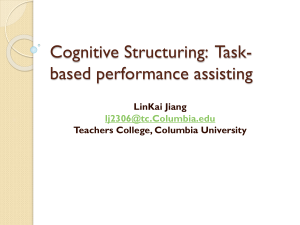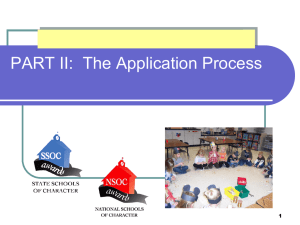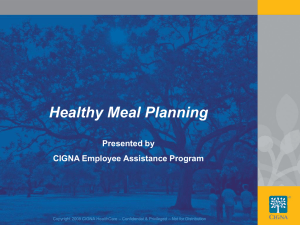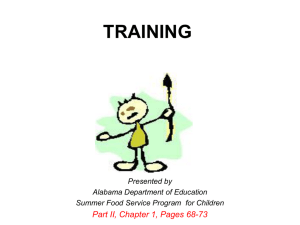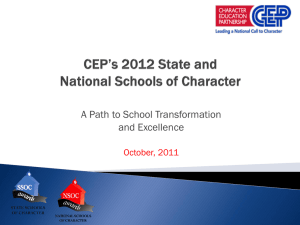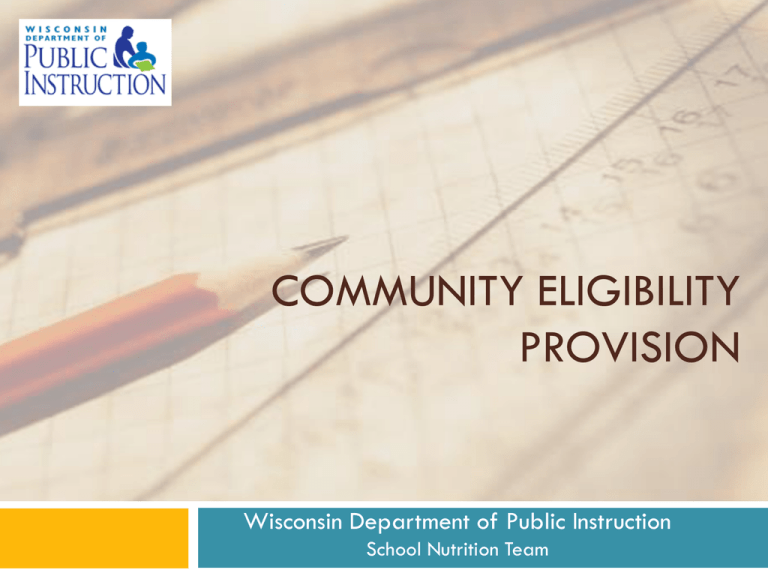
COMMUNITY ELIGIBILITY
PROVISION
Wisconsin Department of Public Instruction
School Nutrition Team
Objectives
Provide Overview of the Community Eligibility
Provision and its Benefits
Identify Eligibility Requirements
Practical Application
Things to Consider
Community Eligibility Provision
Section 104 (a) of the Healthy, Hunger-Free Kids Act of
2010.
An alternative to collecting household applications for
free and reduced price meals in high poverty schools.
Available nationwide beginning July 1, 2014
Benefits of Community Eligibility
All students are offered both lunch and breakfast at no cost
Increases meal participation for breakfast and lunch
Reduces paperwork
Eliminates school meal applications.
Makes school nutrition operations more efficient.
Decreases verification tasks
The SFA will not be required to perform verification
activities for schools choosing CEP.
Note: The verification collection report is still required.
Who is Eligible to elect CEP?
LEAs and schools must have an identified student
percentage of at least 40%.
The 40% threshold can be determined by individual
schools, groups of schools or the entire LEA .
Identified student percentage =
Number of identified students/ enrolled students x
100.
CEP Participation
Eligible LEAs/Schools agree to serve all
students free lunches and breakfasts for 4
successive school years.
Once schools elect CEP, household must be
notified of participation
Identified Students
Identified Students = students directly certified for
free meals without a school meal application.
Directly Certified Students include:
Students in Head Start, Even Start, foster care,
runaway, homeless, or migrant
Students living in households participating in Food
Share, Wisconsin Works (W-2), or FDPIR
Enrolled Students
Students who are enrolled in and attending schools
participating in CEP and have access to at last one
meal service daily.
Half-day students who have access to either
breakfast or lunch would be included.
Students who do not have access to either breakfast
or lunch due to times they are attending school
would not be counted.
How to Determine Identified Student
Percentage
As individual School:
- Identified Student percentage of 40% or
more is required
As group:
- Combine schools in any grouping to meet
meet the Identified Student Percentage
of
or more
As School District:
-All schools may participate, requires total
enrollment 40% or more Identified students
to
40%
Identified Student Percentage
Ex -Good Day School District
School #1 =
Identified
Students – 50
Enrollment – 100
Identified Student percentage = 50/100=50.00%
School #2
Identified
Students – 70
Enrollment – 110
Identified Student percentage = 70/110=63.63%
Combined Identified student %=120/210=57.14%
Identified Student Percentage
Ex -Winter Snow School District
School #1Identified Students– 25
Enrollment – 120
Identified student percentage = 20.83%
School #2 –
Identified Students – 125
Enrollment – 175
Identified student percentage = 71.43%
Combined Identified Student % = (150+295)100=
50.84%
Identified Student Percentage Ex –
Cheddar SD
School #1 Identified Students – 20
Enrollment – 150
Identified student percentage = 20/150=13.33%
School #2 –
Identified Students – 50
Enrollment – 100
Identified Student percentage = 50/100=50.00%
Combined Identified Student % = 28.00%
Reimbursement under CEP
The identified student percentage is multiplied by a factor
(1.6) to determine the percentage of total meals served that
will be reimbursed at the Federal free rate.
The remaining percentage of total meals is reimbursed at the
Federal paid rate.
These claiming percentages are guaranteed for 4 years
Any costs in excess of the total Federal reimbursement must be
covered through non-Federal sources.
Claiming % Ex: Good Day SD
School #1: Identified Student %= 50.00%
School #2: Identified Student % = 63.63%
Combined Identified student % = 57.14%
Claiming Percentage:
57.14
x 1.6 = 91.43% Free rate
100 – 91.43 = 8.57% Paid rate
Claiming % Ex. Winter Snow SD
School #1: Identified student % = 20.83%
School #2: Identified student % = 71.43%
District Identified Student % = 50.84%
Claiming Percentage:
50.84
x 1.6 = 81.35% Free rate
100 – 81.35 = 18.64% Paid rate
Claiming % Ex. Cheddar SD
School #1: Identified student % = 13.33%
School #2: Identified Student % = 50.00%
District Identified Student % = 28.00%
Claiming Percentage:
Only
school #2 can participate = 50 x 1.6 = 80.00%
Free and 20.00% Paid rate
School #1 would count and claim based on eligibility
determined by F/R applications since does not qualify
to participate in CEP
Percentage Increases
Claiming percentage is guaranteed for 4 years
Example:
YEAR
FREE %
PAID %
1 Guaranteed Rate
85.46
14.54
2 (submitted increase)
91.33
8.67
3 (no submitted increase)
85.46
14.54
4 (submitted increase)
89.79
10.21
Meal Counting and Claiming
Meal counts do not need to identify the eligibility of the
student receiving the meal.
Only the total number of reimbursable meals served is
required to claim for CEP.
Count must be taken at the Point of Service
Count complete reimbursable meals only
An LEA may:
Use current POS System
Use a daily count sheet at the Point of Service
What Paperwork Should We Keep?
Paperwork required to support the claim
percentages
All other school meal program paperwork still
applies
Direct Certification Run is still required
What is Direct Certification (DC)?
DC certifies children who
are automatically eligible
for free school meals
because of their foster
child status or because
their households
participate in FoodShare
(SNAP) or W-2 cash
benefits (TANF)
Who’s Involved in Direct Certification?
Schools Food
Authorities
(SFAs)
Department of
Public
Instruction (DPI)
Department of
Children and
Families (DCF)
Direct Certification
Online Process
1. SFAs create the
student enrollment
list
2. SFAs upload
the list to the DCF
website and run
the match process
Direct Cert works best when
qualifying families are enrolled
in public programs. Make sure
families know about
www.access.wi.gov
3. SFAs review
the match file and
send notification
letters to eligible
households
Direct Certification & Community
Eligibility
Identified Students = students categorically
eligible for free meals without a school meal
application.
Identified Students include those students directly
certified for free meals.
Students living in households participating in
Food Share or Wisconsin Works (W-2) and
students in foster care
What’s required of SFAs?
Run direct certification to show eligibility
at the school level
Last Name
First Name
Middle Initial
Date of Birth
School Name
Updated guidance for direct certification
will be coming for the 2014-2015 school
year
Connecting Eligible Children to Healthy
School Meals
Spread the word to families & community
partners
Many families & community partners may be
unaware that students in FoodShare and W-2
cash benefits households are automatically
eligible for free meals at school
Encourage eligible families to apply for
FoodShare and/or W-2 benefits
www.access.wi.gov
Direct Certification Resources
Direct Certification User Guide
http://fns.dpi.wi.gov/files/fns/pdf/dc_ug13b.pd
https://www.dwd.state.wi.us/dcfdirectcert/
Direct Certification webpage
http://fns.dpi.wi.gov/fns_directcert
Direct Certification Resources
CEP & Policy Questions: DPI School Nutrition Team
Email: DPIFNS@dpi.wi.gov
Phone: (608) 267-9228
Technical Questions: DCF Service Desk
Email: dcfservicedesk@@wi.gov
Phone: (608) 327-0840
General Questions: Covering Kids & Families, Marisa and Cherie
directcert@ckfwi.org
Phone: (608) 890-4783
Timeline
April
1: Form due to DPI reporting the identified
student % for each school in LEA
Note: Direct Certification by school site is required
for this form
May
1: DPI will publish a list of Eligible and “Near
Eligible” sites
May
1 - June 30: LEAs and/or schools may apply
to participate in CEP
Financial Feasibility
Schools agree to cover with non-Federal funds any
costs of providing free meals to all students above
amounts provided in Federal assistance
Potential financial impact
Reimbursement Estimator
USDA Monthly Federal Reimbursement Estimator can
assist with determining if participating in CEP
financially feasible
http://fns.dpi.wi.gov/files/fns/xls/cep_re_est.xls
Since students are not being charged for meals,
there will not be additional revenues for reimbursed
meals
Things to Consider for CEP
For the 2014-2015 school year, CEP schools will still be
required to collect individual household income data. This
information is required for other programs such as Title 1,
SAGE and ISIS.
An alternative Household Income Form will be available on the
School Nutrition Team CEP webpage for this purpose at
http://fns.dpi.wi.gov/fns_cep.
Funds from the non-profit school food service account cannot
be used to distribute, process or determine eligibility of these
applications in CEP schools.
Impact of CEP on other Child Nutrition
Programs
Other Child Nutrition Programs will be able to utilize
the percent of meal claimed free to determine their
eligibility in:
Summer Food Service Program (SFSP)
Fresh Fruits and Vegetable (FFVP)
After School Snacks
Child and Adult Care Food Program- After School
at Risk Meals Program
Summary
Provide no costs breakfasts AND lunches to all
students.
Requirement of at least 40% identified student
percentage to qualify.
Additional Materials & Resources
School Nutrition Team website: Website:
http://fns.dpi.wi.gov/fns_cep
CEP
Monthly Reimbursement Estimator
Frequently
USDA
CEP
memos on CEP
Application
Household
Asked Questions
Income Form
FRAC (Food Research and Action Center)
http://frac.org/federal-foodnutrition-programs/
Contact Information
Karrie Isaacson, Assistant Director
School Nutrition Team
karrie.isaacson@dpi.wi.gov
608-266-2416
or
Kathlyn Walter, Nutrition Program Consultant
kathlyn.walter@dpi.wi.gov
608-267-9283
USDA Non-discrimination Statement
The U.S Department of Agriculture prohibits discrimination against its customers,
employees, and applicants for employment on the bases of race, color, national origin,
age, disability, sex, gender identity, religion, reprisal, and where applicable, political
beliefs, marital status, familial or parental status, sexual orientation, or all or part of an
individual’s income is derived from any public assistance program, or protected genetic
information in employment or in any program or activity conducted or funded by the
Department. (Not all prohibited bases will apply to all programs and/or employment
activities.) If you wish to file a Civil Rights program complaint of discrimination, complete
the USDA Program Discrimination Complaint Form, found online at
http://www.ascr.usda.gov/complaint_filing_cust.html, or at any USDA office, or call (866)
632-9992 to request the form. You may also write a letter containing all of the information
requested in the form. Send your completed complaint form or letter to us by mail at U.S.
Department of Agriculture, Director, Office of Adjudication, 1400 Independence Avenue,
S.W., Washington, D.C. 20250-9410, by fax (202) 690-7442 or email at
program.intake@usda.gov. Individuals who are deaf, hard of hearing or have speech
disabilities may contact USDA through the Federal Relay Service at (800) 877-8339; or
(800) 845-6136
USDA is an equal opportunity provider and employer.

